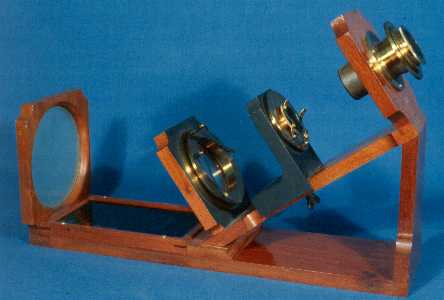At times it is necessary to have a wide field of view for samples
held between crossed polarizing devices. Before the introduction of sheet
polarizers, the practical solution to the problem of producing a linearly
polarized beam of large diameter was the use of polarization by reflection,
with a Nicol
prism used as an analyzer.

|
|
Smithsonian Institution
|
|
Seven devices of this type are shown; these are sometimes
named after Edward Pickering (1846-1919), who introduced laboratory work
in physics to Harvard University. The example at the Judson Collection is
by Stoelting of Chicago, and cost $7.50 in 1912. The arm on the device was
intended to carry a magnifying lens. The polariscopes with the notches taken
out of the corners of their upright wooden plates were made by Queen of
Philadelphia, and cost from $20.00 to $45.00 in 1887. The remaining device
is probably also by Queen, and cost in the $6.00 to $15.00 range. Queen also
sold sets of samples
to be used with the device.
|